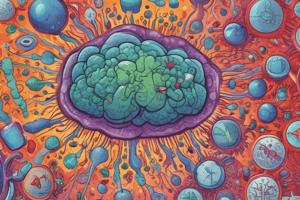Podcast
Questions and Answers
Where are most toxicants deposited in the body due to their high capacity for binding various chemicals?
Where are most toxicants deposited in the body due to their high capacity for binding various chemicals?
Which region of the lungs is mainly responsible for clearing particles sized 2 to 5 m?
Which region of the lungs is mainly responsible for clearing particles sized 2 to 5 m?
What is the main barrier for dermal absorption of chemicals?
What is the main barrier for dermal absorption of chemicals?
Which type of excretion involves the scavenging of toxicants by alveolar macrophages followed by absorption into blood or clearance through lymphatics?
Which type of excretion involves the scavenging of toxicants by alveolar macrophages followed by absorption into blood or clearance through lymphatics?
Signup and view all the answers
Which organ has a relatively good barrier function due to skin not being very permeable?
Which organ has a relatively good barrier function due to skin not being very permeable?
Signup and view all the answers
What is the main route through which particles sized 2 to 5 m are cleared from the tracheobronchiolar regions of the lungs?
What is the main route through which particles sized 2 to 5 m are cleared from the tracheobronchiolar regions of the lungs?
Signup and view all the answers
Which tissue acts as a site where most toxicants preferentially stay due to their storage capacity?
Which tissue acts as a site where most toxicants preferentially stay due to their storage capacity?
Signup and view all the answers
Which layer serves as a barrier in dermal absorption that chemicals must pass through before entering blood and lymph capillaries?
Which layer serves as a barrier in dermal absorption that chemicals must pass through before entering blood and lymph capillaries?
Signup and view all the answers
'Absorption via skin' primarily involves the passage of toxicants through which layer, known for its passive diffusion process?
'Absorption via skin' primarily involves the passage of toxicants through which layer, known for its passive diffusion process?
Signup and view all the answers
Which type of transport process involves carrier-mediated transport that exhibits properties of active transport but does not require energy input?
Which type of transport process involves carrier-mediated transport that exhibits properties of active transport but does not require energy input?
Signup and view all the answers
What is the main barrier for absorption of toxicants through the skin?
What is the main barrier for absorption of toxicants through the skin?
Signup and view all the answers
Where do most toxicants preferentially stay in the body due to their storage capacity?
Where do most toxicants preferentially stay in the body due to their storage capacity?
Signup and view all the answers
Which region of the body is known for bone storage of toxicants due to its high binding capacity?
Which region of the body is known for bone storage of toxicants due to its high binding capacity?
Signup and view all the answers
What type of delivery system involves interaction with cell membranes and different types of barriers to reach target tissues?
What type of delivery system involves interaction with cell membranes and different types of barriers to reach target tissues?
Signup and view all the answers
Where does absorption of toxicants mainly occur in the gastrointestinal tract?
Where does absorption of toxicants mainly occur in the gastrointestinal tract?
Signup and view all the answers
Which size of particles is usually deposited in the nasopharyngeal region?
Which size of particles is usually deposited in the nasopharyngeal region?
Signup and view all the answers
What primarily affects the absorption of aerosols and particles via the lungs?
What primarily affects the absorption of aerosols and particles via the lungs?
Signup and view all the answers
Which organ has specialized transport systems for the absorption of nutrients and electrolytes?
Which organ has specialized transport systems for the absorption of nutrients and electrolytes?
Signup and view all the answers
What is the main function of the nose when it comes to absorption via lungs of highly reactive gases?
What is the main function of the nose when it comes to absorption via lungs of highly reactive gases?
Signup and view all the answers
Which layer acts as a barrier in dermal absorption protecting against the entry of chemicals into blood capillaries?
Which layer acts as a barrier in dermal absorption protecting against the entry of chemicals into blood capillaries?
Signup and view all the answers
Which tissue has a high capacity for binding a multitude of chemicals, concentrating more toxicants than all other organs combined?
Which tissue has a high capacity for binding a multitude of chemicals, concentrating more toxicants than all other organs combined?
Signup and view all the answers
What is the main barrier for chemicals in the dermal absorption process due to its rate-determining function?
What is the main barrier for chemicals in the dermal absorption process due to its rate-determining function?
Signup and view all the answers
Which organ is known for its high capacity to bind a large number of different chemical compounds through interactions involving hydrophobic forces, hydrogen bonding, and Van der Waals forces?
Which organ is known for its high capacity to bind a large number of different chemical compounds through interactions involving hydrophobic forces, hydrogen bonding, and Van der Waals forces?
Signup and view all the answers
Through which process do particles sized 1 μm and smaller penetrate into the alveolar sacs of the lungs?
Through which process do particles sized 1 μm and smaller penetrate into the alveolar sacs of the lungs?
Signup and view all the answers
What is the primary route through which toxicants are absorbed via skin before entering blood and lymph capillaries?
What is the primary route through which toxicants are absorbed via skin before entering blood and lymph capillaries?
Signup and view all the answers
Where do toxicants like to stay primarily due to their storage capacity?
Where do toxicants like to stay primarily due to their storage capacity?
Signup and view all the answers




